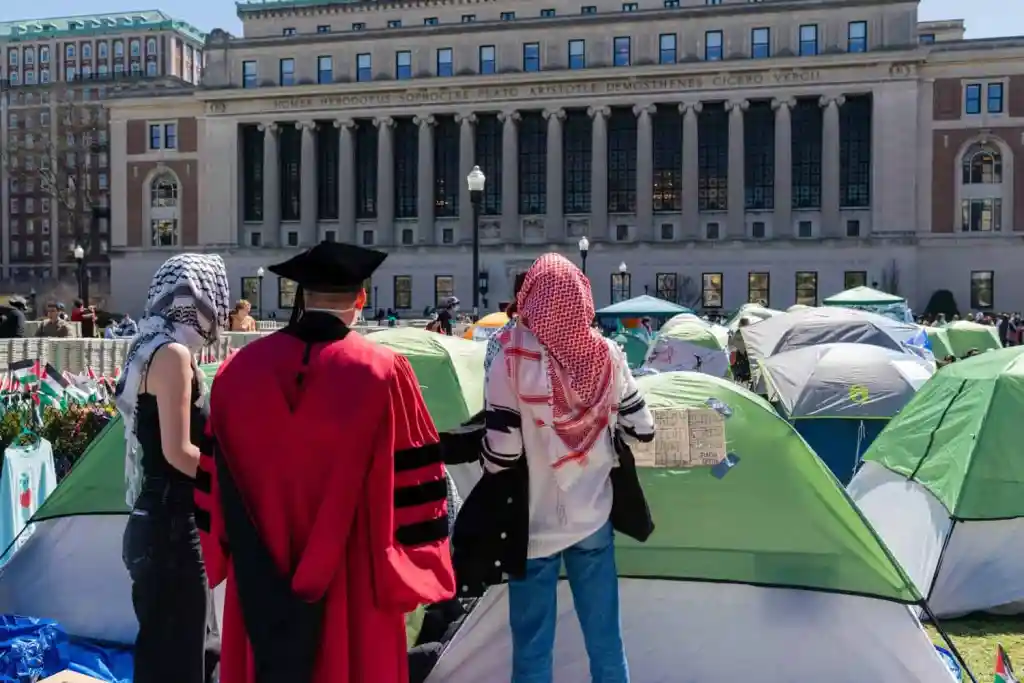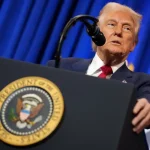
Shifting Leadership at Columbia: A Deep Dive into Recent Changes and Their Implications
Posted in :
Leadership Crisis at Columbia University: What It Means for Higher Education
This blog post explores the recent resignation of Columbia University’s interim president, Katrina Armstrong, in the context of escalating tensions over federal funding and campus protests. It examines the implications for the university and the student body, analyzing the response from both administration and academics following Armstrong’s departure.
The recent resignation of Columbia University’s interim president, Katrina Armstrong, took me by surprise. Reflecting on my college years, I remember the ebb and flow of administration changes, often brought about by external pressures. Armstrong’s exit, amidst negotiations over significant federal funding, shines a spotlight on a broader trend impacting educational institutions today. What does it mean for a once-proud institution to have its leadership shift under duress?
The Climate of Change at Columbia University
Columbia University is experiencing a significant shift in its leadership. Recently, interim president Katrina Armstrong announced her decision to step down. This marks the second major leadership change at the university in less than a year. What does this mean for Columbia and its community? Let’s dive into the details.
Overview of Recent Leadership Changes
Armstrong’s departure is not just a simple resignation. It comes at a time of great uncertainty and unrest within the university. The Board of Trustees expressed gratitude for her service, stating, “Dr. Armstrong accepted the role of interim president at a time of great uncertainty for the University and worked tirelessly to promote the interests of our community.”
But why is this happening? The university has faced significant protests and external pressures. These challenges have put immense strain on its leadership. Armstrong’s exit follows the resignation of former president Minouche Shafik in 2024. Shafik’s tenure was marked by protests and accusations of failing to adequately address issues of antisemitism on campus. The rapid turnover in leadership raises questions about the stability of governance at Columbia.
Context of Minouche Shafik’s Resignation
Shafik’s resignation was a pivotal moment for Columbia. Her time as president was characterized by large-scale protests, including students occupying university buildings. These protests were fueled by a growing discontent with the administration’s handling of various issues, particularly around free speech and campus safety.
Critics argued that Shafik allowed multiple police operations against protesters, a move reminiscent of the tumultuous protests during the Vietnam War. This led to accusations that she tolerated antisemitism, which further complicated her leadership. The environment became increasingly hostile, leading to her decision to step down.
How These Transitions Reflect Wider Trends in Higher Education
These leadership changes at Columbia are not isolated incidents. They reflect broader trends in higher education across the United States. Many universities are grappling with similar issues, including protests, funding threats, and external pressures from political entities. The quote from an education expert resonates here:
“Leadership changes at educational institutions often reflect broader societal issues, highlighting how external pressures can reshape internal dynamics.”
Columbia’s challenges are emblematic of a larger crisis in academia. Institutions are facing increasing scrutiny over their responses to social movements and political pressures. The recent negotiations with the Trump administration over $400 million in federal funding illustrate this point. Columbia is under pressure to address allegations of antisemitism amid ongoing pro-Gaza protests. The university has agreed to implement significant changes, such as establishing a new campus police force and limiting faculty control over certain academic departments.
These decisions have sparked outrage among academics and students alike. Many see them as an unprecedented capitulation to outside influence, raising concerns about academic freedom and the integrity of educational institutions. Are universities compromising their values to secure funding? This question looms large as we observe the unfolding events at Columbia.
As we reflect on the recent leadership changes at Columbia University, it’s clear that these transitions are more than just administrative shifts. They are indicative of a larger struggle within higher education. The pressures faced by Columbia mirror those experienced by many institutions today. The question remains: how will these changes shape the future of Columbia and its commitment to academic freedom and integrity?
In the midst of these upheavals, one thing is certain: the climate of change at Columbia University is far from over. The community will be watching closely as the university navigates these turbulent waters.
The Fallout from Federal Funding Threats
Columbia University is currently navigating a turbulent landscape, one that is heavily influenced by federal funding threats. The Trump administration has put a staggering $400 million in federal funding on the line, and the implications of this situation are profound. It’s not just about money; it’s about the very essence of academic freedom and integrity.
The $400 Million Question
What does it mean when a university stands to lose $400 million? This amount is not just a number; it represents resources that support research, scholarships, and various academic programs. Losing such funding could cripple Columbia’s operations. The administration claims that this funding is contingent upon the university’s actions regarding allegations of insufficient measures against antisemitism. This has sparked a heated debate about the role of federal influence in university governance.
Implications of Federal Threats
When the federal government threatens funding, it sends shockwaves through university operations. The Trump administration has positioned itself as a key player in these funding decisions, a scenario that is quite unusual in traditional academia. This pressure can lead to significant changes in university policies and practices. But at what cost?
- Increased oversight of campus activities.
- Potential alterations to academic programs to align with federal expectations.
- Pressure on faculty and administration to conform to external demands.
As one
“Funding threats are a powerful tool in shaping the policy decisions at universities.” – Higher Education Policy Analyst
This statement encapsulates the reality many institutions face today. The fear of losing funding can lead to a troubling capitulation by educational leaders, who may prioritize financial survival over academic integrity.
Columbia’s Response
In response to these threats, Columbia has agreed to implement sweeping changes. These adjustments are aimed at appeasing the federal government and securing the vital funding. Some of the proposed changes include:
- Establishing a new campus police force.
- Partially banning face masks during protests.
- Removing faculty control over the department of Middle East, South Asian, and African Studies.
These measures have drawn criticism from both within and outside the university. Many academics view this as an unprecedented capitulation to external influence. It raises a critical question: Are we sacrificing academic autonomy for financial security?
Concerns About Academic Integrity
The changes Columbia is making to secure funding have raised alarms about the university’s commitment to academic freedom. The very essence of education is to foster open dialogue and critical thinking. When external pressures dictate university policies, it can stifle these core values.
Moreover, the implications extend beyond just funding. They touch on the broader issue of how universities interact with governmental power. Are we witnessing a shift where academic institutions become pawns in political games? This is a troubling thought for anyone who values the independence of higher education.
As we observe these developments, it’s essential to consider the long-term effects. Will universities continue to bend to external pressures? Or will they stand firm in their commitment to academic integrity? The outcome of this situation could set a precedent for how universities operate in the future.
In conclusion, the fallout from federal funding threats is a complex issue that goes beyond mere dollars and cents. It challenges the very foundation of what it means to be an academic institution. As Columbia navigates this treacherous terrain, we must remain vigilant and question the implications of such funding threats on our educational landscape.
Campus Activism and Administrative Responses
In recent times, we’ve witnessed a surge in campus activism, particularly at Columbia University. This wave of activism isn’t just a fleeting trend; it represents a profound shift in how students engage with their universities and the world around them. The recent protests against Israel’s policies are a prime example. These protests reflect a new generation of students who are deeply invested in social justice issues. But what does this mean for the relationship between student bodies and university administration?
Responses from Student Bodies
Student bodies have been vocal in their responses to administrative actions. They are not just passive observers; they are active participants in shaping the dialogue on campus. When the administration makes decisions that students perceive as unjust, the response can be swift and powerful.
- Students organized protests to voice their concerns over administrative policies.
- They have rallied together to demand accountability and transparency from their leaders.
- In many cases, these protests have led to significant changes in university policy.
Take, for instance, the recent protests at Columbia. Students united to challenge the administration’s handling of sensitive issues related to the Israel-Palestine conflict. Their collective voice has made it clear: they will not stand idly by while their university navigates these complex issues without their input.
The Role of Activism in Shaping Campus Dialogue
Activism plays a crucial role in shaping campus dialogue and policy. It challenges the status quo and encourages open discussions about difficult topics. Through protests and organized movements, students are not just expressing dissent; they are advocating for change. This activism fosters a culture of engagement and dialogue, which is essential in any academic environment.
As one student leader at Columbia put it,
“Students have a unique power to influence governance at their universities, especially in times of political tension.”
This statement encapsulates the essence of student activism today. It’s about empowerment and the belief that students can drive meaningful change.
Highlighting Key Protests and Movements within Columbia
Columbia has been the epicenter of significant protests in recent years. These movements have not only highlighted the students’ concerns but also brought national attention to the issues at hand. For example, the protests against the university’s response to allegations of antisemitism during pro-Palestine demonstrations have sparked heated debates about free speech and institutional responsibility.
Moreover, the administration’s recent decisions, such as implementing a new campus police force and altering faculty control over certain departments, have drawn criticism. Many view these changes as a capitulation to external pressures rather than a genuine effort to address the concerns of the student body. This has led to further protests and a call for greater student involvement in governance.
Resistance to administrative decisions showcases the empowered voice of students today. They are not afraid to challenge authority and demand accountability. This is a testament to the changing landscape of higher education, where students are increasingly aware of their rights and responsibilities.
The protests at Columbia University have set the stage for a national dialogue surrounding free speech and institutional responsibility. As we navigate these complex issues, it’s clear that student activism is not just a reaction; it is a vital part of the academic landscape. The empowered voices of students are shaping the future of their universities, and their actions are a reminder that change is possible when individuals come together for a common cause.
In this era of heightened political tension, the role of students in influencing governance cannot be overstated. They are not just participants in their education; they are active agents of change. As we look ahead, it will be fascinating to see how this activism continues to evolve and impact the broader conversation about social justice and institutional accountability.
TL;DR: Katrina Armstrong resigns as Columbia’s interim president amid federal funding disputes and campus unrest, marking another leadership transition in a turbulent period for the university.
ColumbiaBoardOfTrustees, UniversityFundingIssues, HigherEducationProtests, KatrinaArmstrongResignation, TrumpAdministration, AntisemitismClaims, ColumbiaUniversityLeadership, Pro-PalestineProtests, StudentActivism, FederalFundingNegotiations
ColumbiaBoardOfTrustees, #HigherEducationProtests, #ColumbiaUniversityLeadership, #AntisemitismClaims, #UniversityFundingIssues, #FederalFundingNegotiations, #Pro-PalestineProtests, #KatrinaArmstrongResignation, #TrumpAdministration, #StudentActivism#ColumbiaUniversity, #LeadershipChange, #AcademicFreedom, #HigherEducation, #FederalFunding, #StudentActivism, #KatrinaArmstrong, #CampusProtests, #UniversityPolitics, #InstitutionalGovernance

